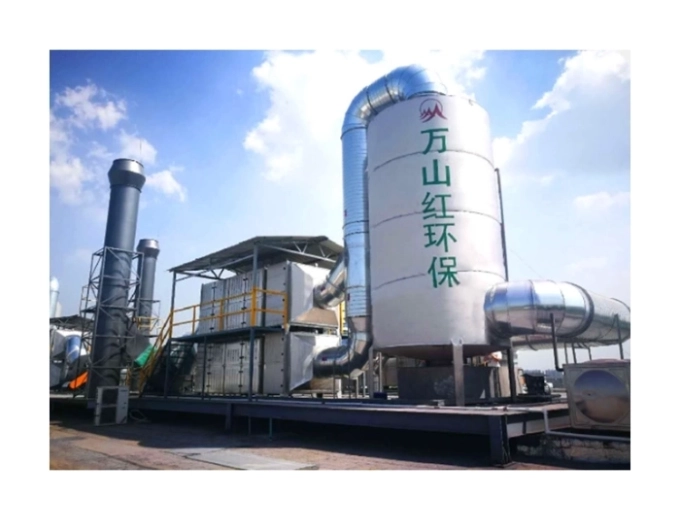Analysis of Common VOC Waste Gas Treatment Technologies and Their Advantages and Disadvantages
Release time: 2025-09-09
Table of Contents
In modern industrial production, VOC (volatile organic compound) emissions have become a major environmental challenge. To effectively address VOC waste gas pollution, many companies have opted for specialized VOC waste gas treatment equipment. Wan Shanhong will introduce several common VOC waste gas treatment technologies and their advantages and disadvantages to help companies make more informed decisions when selecting an appropriate waste gas treatment solution.
Adsorption Method
The adsorption method removes pollutants by combining adsorbent materials (such as activated carbon and molecular sieves) in VOC waste gas treatment equipment with harmful substances in the waste gas. This method is widely used in various industries, especially in factories that use a lot of solvents.
Advantages:
Suitable for treating low-concentration VOC waste gas, requiring relatively low equipment investment.
High treatment efficiency, effectively removing harmful components from the gas.
Equipment is simple to operate and maintain.
Disadvantages:
The adsorption capacity of the adsorbent material is limited, requiring regular replacement or regeneration of the adsorbent, increasing operating costs.
The treatment effect may be unsatisfactory for high-concentration VOC waste gas.
Incineration (Thermal Oxidation)
Incineration is a technology that heats the exhaust gas from the VOC waste gas treatment equipment to a high temperature, causing organic matter to decompose into carbon dioxide and water. This method is suitable for high-concentration VOC waste gas and is particularly widely used in industries such as the petroleum and chemical industries.
Advantages:
It can completely decompose VOCs, ensuring that the exhaust gas meets environmental standards.
It is suitable for treating high-concentration VOC waste gas and has relatively stable treatment results.
Disadvantages:
It consumes a lot of energy and has high operating costs.
It requires high-temperature resistance for the equipment and may require additional safety measures.
Condensation Method
The condensation method reduces the temperature of the VOC waste gas treatment equipment, causing the volatile organic compounds in the gas to condense into a liquid, thereby separating the harmful components. This technology is typically used to treat low-concentration, low-temperature VOC waste gas.
Advantages:
It has good treatment effects on low-concentration VOC waste gas, can recover organic matter, and has certain economic benefits.
It has low energy consumption and is easy to operate.
Disadvantages:
Can only treat low-concentration VOC waste gas and has limited effectiveness against high-concentration waste gas.
Sensitive to temperature fluctuations, the equipment may require additional refrigeration, increasing costs.
Catalytic Oxidation
Catalytic oxidation utilizes a catalyst within the VOC waste gas treatment equipment to promote the oxidation reaction of VOCs at relatively low temperatures, converting them into harmless gases. This technology is widely used in industries such as the chemical and printing industries.
Advantages:
Efficiently decomposes VOCs at relatively low temperatures, saving energy.
Suitable for a wide range of organic waste gas types, offering wide applicability.
Disadvantages:
The catalyst has a limited lifespan and requires regular replacement.
High maintenance requirements are required for the equipment, and improper maintenance may affect treatment effectiveness.
Biological Filter
The biological filter method utilizes the metabolic activity of microorganisms to decompose organic matter in VOC waste gas. This technology is primarily used to treat low-concentration, low-toxicity VOC waste gas.
Advantages:
Relatively stable treatment results and environmentally friendly.
Suitable for treating low-concentration VOC waste gas and achieving high removal efficiency.
Disadvantages:
Control of the microbial growth environment, such as humidity and temperature, is required, making operation more complex.
Poor treatment effectiveness for high-concentration VOC waste gas.
Summary
Choosing an efficient VOC waste gas treatment technology depends on a variety of factors, including waste gas concentration, composition, treatment scale, and the company’s budget. For low-concentration VOC waste gas, adsorption and biofiltration may be better options; for high-concentration waste gas, incineration or catalytic oxidation are more suitable. Regardless of the technology chosen, understanding its advantages and disadvantages and selecting it based on the company’s specific needs will achieve the best environmental performance.
When selecting VOC waste gas treatment equipment, companies should consider the long-term return on investment, operating costs, and equipment maintenance requirements. With increasingly stringent environmental regulations, adopting advanced VOC waste gas treatment technology can not only help companies reduce environmental pollution but also enhance their social responsibility image and ultimately gain more market opportunities.



